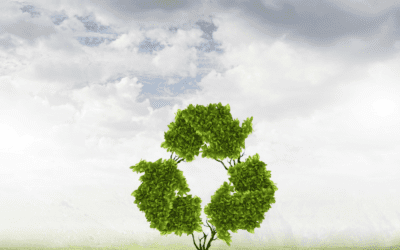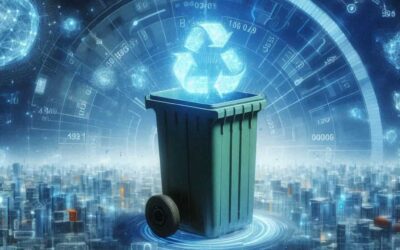Plastic isn’t going anywhere. We use it in everything from medical devices to food packaging, and it has positive qualities that make it a material of choice. There are two huge problems with plastic, however. First, it takes significant natural resources to make new plastic. And second, it can take hundreds of years for plastic to break down – and all the while it is leaching toxins into our air, soil and waterways.
In our everyday lives, we think we are helping to solve this problem by recycling the plastic we use. But the UN Environment Programme (UNEP) has reported that in 2021, plastic accounted for 85% of all marine litter, and that globally, around 50% of all the plastic we use still ends up in landfill.
In fact, UN Environment Programme Executive Director, Inger Andersen says: “We will not recycle our way out of the plastic pollution crisis: we need a systemic transformation to achieve the transition to a circular economy.”
How big is the plastic problem?
We could easily fill this article with huge, frightening facts and figures. The fact is that plastic is a problem. The way we create new plastics is problematic. The way we consume plastics is problematic, and the way we dispose of plastics is problematic.
According to Plastics Europe, worldwide plastics production stood at 367 million tonnes in 2020. That’s not including any production using recycled plastics. Those plastics are destined for use in a wide range of markets – the percentages below are for the EU27+3 countries covered in the Plastics Europe report:
- Packaging – 40.5%
- Building and construction – 20.4%
- Automotive – 8.8%
- Electrical and electronics – 6.2%
- Household, leisure and sports – 4.3%
- Agriculture – 3.2%
- Other – 16.6%
According to a paper published by Professor Christos Tsinopoulos, Dr Riccardo Mogre and Onur Ağca of Durham University in 2021, “… only 6% of the nine billion plastics that have been produced since the 1950s have been recycled, and more than half of these have gone to landfill as waste.”
So plastic poses a big problem for the planet and its survival. It’s a critical material in many ways, but both its production and its end-of-life management are damaging to the environment, and therefore to our long-term climate security.
A complex challenge
Solving the plastics crisis – and that’s what it is – is not as easy as it might seem at first glance. There are three main ways of dealing with plastic at the end of its life – and don’t forget that the ‘end of life’ isn’t after years and years of use. It’s after you’ve finished your yoghurt, or unpacked your new phone or drained your takeaway coffee.
Recycling
In the UK and other pro-recycling countries, plastic recycling is heavily encouraged. From dedicated containers at local waste sites to kerbside recycling, governments and environmental groups have spent many years trying to change our throwaway habits. The consequence is that many of us now naturally ‘recycle’ our plastic products.
But what actually happens to the plastic we carefully wash and put in our bins? The recycling ecosystem is so complex that even in the UK, approaches to recycling can differ. A 2021 article from Greenpeace claims that thousands of tonnes of the plastic we recycle actually ends up in incinerators, or is shipped off to other countries – where we lose sight of how it is treated. And some plastic may still end up in landfill, where it will take hundreds of years to break down.
Furthermore, we can’t assume that recycling plastic actually makes a significant difference. According to The World in Data, recycling has the lowest global warming potential and total energy use. However, it also notes that many plastics are not suitable for constant recycling, and can only be recycled two or three times before heading for the same treatment as other plastic waste.
In addition, we’re still creating a lot of new plastics. So recycling at end of life doesn’t automatically reduce the amount of new plastics being created.
Incineration
Incineration can be a good option for managing plastic waste, if the plant is a waste-to-energy plant. Incineration needs to be efficient to avoid releasing greenhouse gasses into the atmosphere. Where incineration is just a method of getting rid of the plastics, it can be an environmentally dangerous option. Where the energy is turned into fuel, this can be a positive outcome, but siting waste-to-energy plants is contentious among local communities, and the plants need to be properly and rigorously regulated to make sure they are performing safely and efficiently.
Landfill
More than half of our plastic waste still ends up in landfill. The impact that creates – much like incineration – depends on the location and management of the landfill site. Developed countries tend to bury landfill waste, while other countries simply have huge, open sites. Landfill should always be the last option – decomposing materials leak greenhouse gasses into the air, and toxins into the soil.
We haven’t talked here about the plastic that ends up in the world’s oceans. It’s well documented that a significant proportion of plastic ends up in the ocean, damaging marine wildlife and undersea structures. The UNEP predicts that by 2040, there will be 27 million metric tonnes of plastic waste going into the oceans every year.
What does the future look like?
As the UNEP Executive Director says, we need a systemic transformation in the way we make, use and dispose of plastics. For consumers, that means thinking about:
- Significantly reducing single-use plastics wherever possible
- Reuse existing plastics wherever possible, to extend their lifespan
- Recycle intelligently – know what can and can’t be recycled
For businesses, it means:
- Using alternative sources of plastic production, including bio-based innovations
- Changing to sustainable, compostable, biodegradable or recyclable packaging
- Assessing both your supply and sales chains for sustainable approaches
- Encourage customers to choose plastic-free options
- Measure plastic use to benchmark progress
- Encourage plastic-free habits in the workforce
And for governments, it means:
- Look at better ways of managing plastic waste, including reliable waste-to-energy plants
- Legislate on plastic issues, such as banning plastic bags, mandating better packaging and single-use plastics
- Take a lead in using reliably-recycled materials in infrastructure and other projects
- Impose levies and fines that encourage plastic reduction
- Work collaboratively with other countries to promote better production and reuse of plastic products
Our planet has finite resources, and we can’t keep exploiting those resources for ever – that will have fatal consequences for our existence. So we must act now to improve plastics production, reduce harmful plastic waste and learn to work together to drive a circular plastics economy that benefits us all.
To learn more about ISB Global and our mission to change how the world views and deals with waste, contact the team today or alternatively request access to the Interactive Showcase of our Software below:






